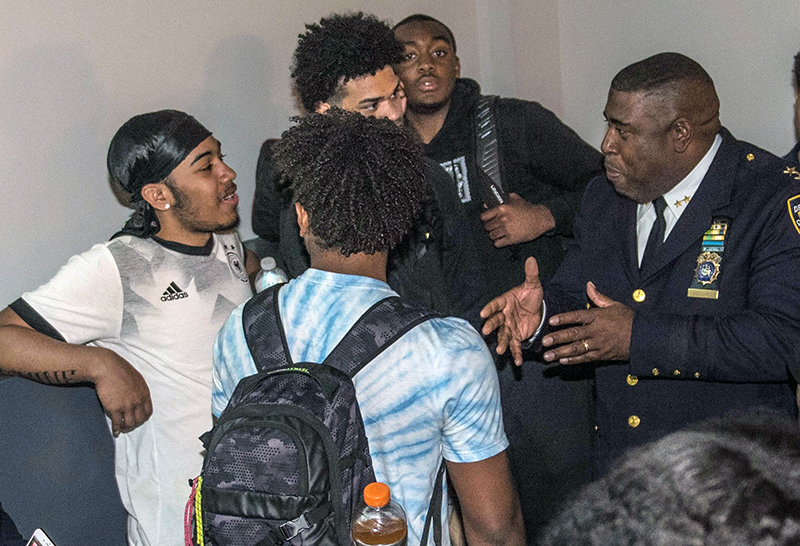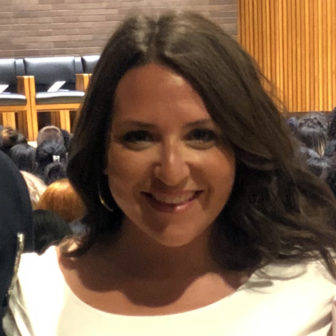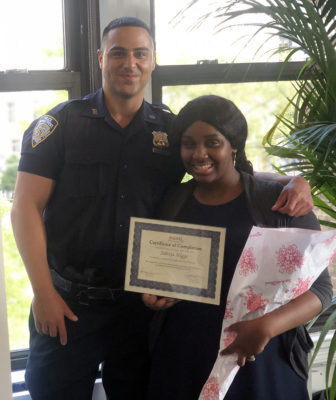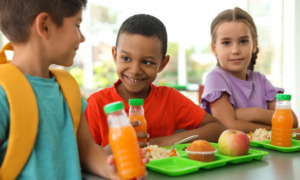
Photos by Sue Kwon for NYC Together
New York Police Department Assistant Chief Jeffrey Maddrey talks to high school students after a viewing of “Raised in the System.”
NEW YORK — Dana Rachlin and other activists around juvenile justice have been waiting a long time for the city to limit police involvement in the schools.
Last month the city announced New York Police Department school safety agents will no longer issue a summons or arrest for low-level offenses like disorderly conduct, spitting, graffiti or marijuana possession.
Since 2015, Rachlin has been working to connect high school students with police officers through the organization she founded, NYC Together. Expanding on previous NYPD initiatives, including the Juvenile Robbery Intervention Program, which was criticized for not stopping robberies, Rachlin aimed to create communities that were both safe and fair.

Dana Rachlin
“The premise was wonderful but it was missing some pieces,” said Rachlin, referring to the Juvenile Robbery Intervention Program, but “now the [NYPD] is in a great place because of education and training.”
That training goes beyond just tactical instruction, including implicit bias, racial and LGBTQ sensitivity and crisis intervention, she said. The NYPD has let officers know they can be in a supportive role by starting neighborhood policing initiatives and ending the stop and frisk program, she said.
NYC Together pairs students having issues in school with a police officer for a year. When schools identify students who are habitually late, chronically absent or have failing grades, NYC Together tells them they are now in a leadership position to serve as liaisons between their community and local law enforcement. The kids are usually eager to let a cop know what’s on their mind, Rachlin said. It’s also critical that the students are not seen as informants in the eyes of their peers, but rather as liaisons to the community.
Broadening their world
For 17-year-old Royal-Hyness Allah, the program has helped him better understand the legal system and how to handle issues like racism. Workshops where the officers and students read about different scenarios and had to respond introduced him to a world beyond his neighborhood and prepared him to handle situations he wouldn’t have been exposed to otherwise.
“[It] helps you think before you do,” Allah said. “This program let us learn how to move accordingly.”
Another NYC Together member said she changed her act after becoming part of the program. Jalexia Higgs, 17, is about to start a new job at a nail salon. Thanks to the program, she said, she has become more punctual, responsible and willing to learn new things. Higgs got to hear other viewpoints and share her own ideas about how to improve the criminal justice system.
She’s concerned about the black-on-black crime in her community and thinks people need to unite to reduce gang violence because she’s “tired of hearing people of my same skin color dying.”
Higgs said she also thinks the police should make a person feel comfortable before pulling their gun because many situations don’t need a gun. They need to communicate first, she said.
Members of local law enforcement have benefitted too.
A deeper bond
Assistant Chief Jeffrey Maddrey oversees 10 precincts in the northern section of Brooklyn as the commanding officer of NYPD Patrol Borough Brooklyn North. When he became involved in NYC Together four years ago, he was amazed because by sitting down and listening to the young people share their stories, he could see the life the program was breathing into them.
NYC Together has helped foster relationships between the police and youth in his neighborhood, he said. Cops can always use their discretion on certain violations that amount to crimes, but that might only mean giving young people a break every now and then, he said, without providing any kind of a sustainable solution to their issues.

Officer Justin Torres and Jalexia Higgs at her graduation from a program he had referred her to.
This program helps police officers take that initiative a few steps further by creating a deeper bond between two different groups of people, Maddrey said. Now, officers are taking an interest in young people, following up and being a part of their life.
“It’s a great feeling to know that these police officers can work with these children who hear negative commentary about being around the police,” he said, “so they can see us for who we are and vice versa.”
As he’s driving down the streets, he said, it’s wonderful to hear the kids calling “Chief” to him. He thinks NYC Together is a powerful program with a strong impact on young people.
Despite being a one-woman operation, NYC Together has garnered support from local radio DJs, formerly incarcerated individuals and activists like Ndaba Mandela. It now operates in the entire northwestern part of Brooklyn. To rethink law and order, and increase public safety, the city must work toward restorative justice and problem solving that can’t be solved by incarceration, Rachlin said.
“We can’t have criminal solutions to social problems,” she said, and “we see young people as having the ability to educate us.”





























